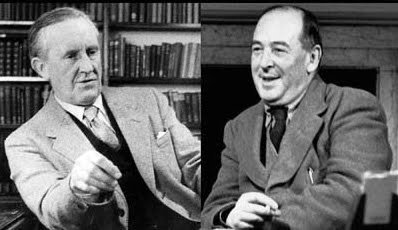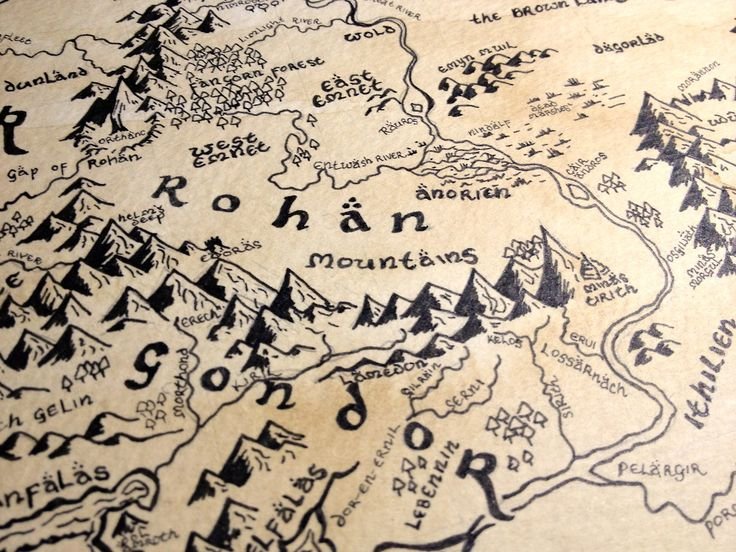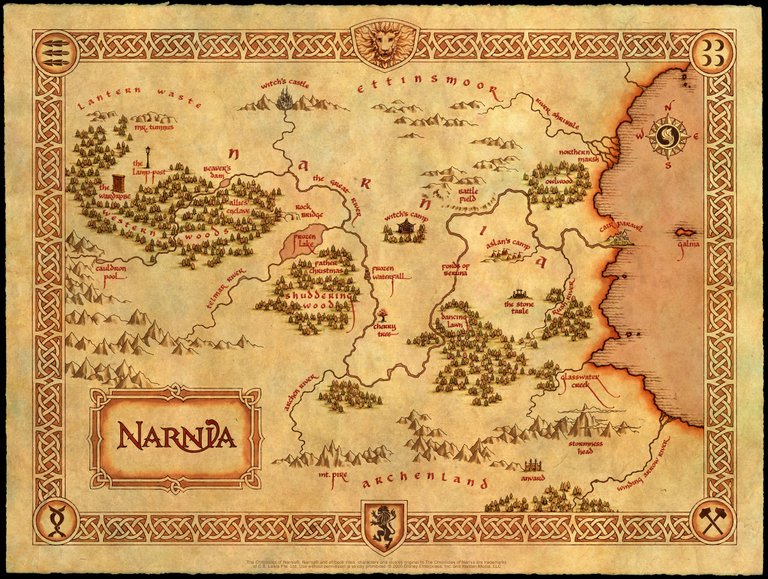
J.R.R. Tolkien and C.S Lewis
In his essay “On Fairy Stories,” J.R.R Tolkien, author of the beloved The Hobbit and The Lord of the Rings, wrote about the process of world-building – the act of building an imaginary world. Tolkien distinguishes our world, called the Primary World, from an imaginary world that only exists in an author’s mind, called the Secondary World. (If you haven’t had a chance to read Tolkien’s essay, I highly recommend it. You can find the full essay here: http://brainstorm-services.com/wcu-2004/fairystories-tolkien.pdf)
Tolkien spent many years carefully constructing his Secondary World, called Middle Earth. He created multiple languages, a complete history of his world, different races (Elfs, Dwarfs, Men, Hobbits, Ents, Goblins, Orcs, Wizards, to name only a few), and new cultures.
C.S Lewis, the author of The Chronicles of Narnia, was close friends with Tolkien and the two men were part of a writers’ group called the Inklings. Lewis was also a worldbuilder and created the world of Narnia. However, when Lewis first shared Narnia with Tolkien, Tolkien was less than encouraging:
“Tolkien deemed the book [The Lion, the Witch, and the Wardrobe] almost worthless – a carelessly written jumble of unrelated mythologies. He simply detested it” (Seddon 61).
Middle Earth and Narnia
Tolkien detested Narnia because he thought it was too cluttered. While Tolkien carefully constructed Middle Earth as a completely separate world from the Primary World, Lewis included familiar aspects from the Primary World in his Secondary World. Lewis included Beatrix potter-like talking animals, Father Christmas (aka Santa Claus) creatures from Greek mythology like centaurs and fauns, and creatures from Roman mythology, like Bacchus, in his world. Lewis also built a bridge between the Primary World and Narnia when he brought children from our world into Narnia. Middle Earth is untouched by the Primary World but Narnia receives visitors from the Primary World, who then bring aspects of the Primary World into the Secondary World, perhaps “tainting it,” in Tolkien’s view.
My favourite example of the Primary World reflected in Narnia is the description of Prince Rilian in The Silver Chair: “He was dressed in black and altogether looked a little bit like Hamlet” (131). Perhaps Tolkien saw references to the Primary World as breaking the suspension of disbelief, which causes “the magic, or rather art [to fail]” (Tolkien 12).

Conclusion
Tolkien’s initial perception of Narnia is clearly wrong as The Chronicles of Narnia has gone on to be one of the most successful, popular and beloved children’s series since its publishing. However, do you think that Tolkien’s Middle Earth is superior to Narnia because it can stand alone as a Secondary World, untainted by our Primary World? Does Narnia truly break the suspension of disbelief? Does suspension of disbelief matter when entering into a Secondary World as a reader?
What do you think?

All images were taken from Google Images.
Lewis, C.S. The Silver Chair. Macmillan Publishing Co., 1970.
Seddon, Eric. “Letters to Malcolm and the trouble with Narnia: C.S. Lewis, J.R.R. Tolkien, and
their 1949 crisis.” Mythlore, vol. 26, no. 1-2, 2007, p. 61+. Literature Resource Center, go.galegroup.com/ps/i.dop=LitRC&sw=w&u=briercrest&v=2.1&it=r&id=GALE%7CA171579958&asid=78b1774346b6cc60f2e5598b913d3fc5.
Schakel, Peter J. The Way Into Narnia: A Reader’s Guide. Wm. B. Eerdmans Publishing, 2005.
Tolkien, J.R.R. “On Fairy Stories.” Essays Presented to Charles Williams. Wm. B Eerdmans, 1947.
Just a quick question: why send readers to Google is you can link to the essay? Aside from that: good post. I think that rather than disrupt the sense of magic, Lewis' Secondary World brings the reader closer to the story by having the worlds "touch" in the book. I think it just speaks to a different kind of reader audience. Some prefer a bit of Primary World in their fantasy, while others prefer to distance themselves from it completely. It's also apparent in scifi with franchises like Star Wars that exist in their own Secondary World unrelated to our Primary.
Thanks for your feedback. That's true, I should have just put the link to the essay on the post itself (http://brainstorm-services.com/wcu-2004/fairystories-tolkien.pdf).
I think you are right that different Secondary Worlds are more popular with different people. Tolkien preferred to keep Middle Earth separate and many Tolkien fans appreciate that, while Narnia fans see nothing wrong with including aspects of the Primary World in his Secondary World. Personally, I think that Narnia is even more intriguing because it includes aspects of classical literature and myths which are familiar to us, but made new and magical in the world of Narnia.
I must answer, because I am a Tolkien fan and also saw Narnia. I think that without Tolkien Narnia wouldn't have been such a success, like most of fantasy stories which came after Lord of the Rings. I guess Tolkien set a stone. But that is only my subjective estimation. ...
Like: without Star Wars Science Fiction wouldn't have become so popular.
I'm reluctant to say that Tolkien alone made the genre of fantasy popular. Fantasy, or "fairy stories" as Tolkien likes to call it (see Tolkien's essay), were very popular long before Tolkien wrote The Lord of the Rings or even The Hobbit. Tolkien was heavily influenced by George MacDonald's fairy tales, which were written in the nineteenth century.
I'm also reluctant to say Tolkien's work made The Chronicles of Narnia popular. The Lion, the Witch, and the Wardrobe (1950), Prince Caspian (1951), The Voyage of the Dawn Treader (1952) and The Silver Chair (1953) were all published, and became wildly successful, before The Lord of the Rings was released in 1954. Tolkien and Lewis' stories and writing style, as well as their worlds, are also so different, I don't think it is fair to compare them on the same scale. Both Tolkien and Lewis are brilliant worldbuilders and storytellers, and I think each must be appreciated on their own, although we, as readers, are allowed to have our favourites. :)
Totally:) - I wanted to point out that those writers who have made it into the top are great influencers of what comes after them. I was watching from above and that was the first thought popped into my head as I read your post.
For the non educated reader - like me - it seems to be like it was the case I mentioned. I guess I represent the mass for I did not read Lewis but only saw the movie.
So it is good to be corrected.
I appreciate art wherever it is folding up in front of me.
Which of the Narnia movies did you see? What did you think of them? The Lion, the Witch, and the Wardrobe follows the events of the book pretty accurately but Prince Caspian and The Voyage of the Dawn Treader are only loosely based on the books.
As someone who passionately loves both, it thrills me to read this. I didn't know they were friends. It's so humbling to imagine them sitting together sharing and critiquing some of the best fiction writing of the 20th century.
It's clear Tolkien really had the all-in philosophy, total immersion. The down side is that there's no path there. Lewis gives us a path, like you have with Harry Potter, where you can dream that one day you'll find a magical wardrobe or get an invitation to Hogwarts. I think it also has to do with Narnia and Potter both being generally directed to children, though, of course, most of the rest of us were also captivated. Children always believe they can create and find magic. Whereas middle earth was a way to mentally escape to a totally alternate universe without seeing a way there.
Thanks for posting this. I love thinking about this stuff.
I would argue that Middle Earth can also be directed to children as well, as The Hobbit was originally written for Tolkien's children. Tolkien also created Middle Earth because he wanted to create a unique mythology for England. In that way, I think that Middle Earth could be considered closer to home than we might think, especially if we imagine that the history and land of Middle Earth happened long ages ago in our Primary World... Middle Earth can be thought of like the world of Arthurian legends or Greek mythology - it happened in the past and you'd just need a time machine to get there, whereas for Narnia and Harry Potter, you just need a portal to get to that other world.
Excellent points! I had read that about The Hobbit but had forgotten. What a dad! What lucky kids. I think just for me I remember hoping as a child I would one day find a wardrobe, and both my older children told me they were really disappointed when they didn't get a Hogwarts letter. I loved The Hobbit and all the Lord of the Rings books, but I never thought of being in the world. It does, though, like you say, have a feeling of an ancient history.
Wonderful essay and definitely got me thinking about something that, admittedly, had never occurred to me before. I suppose I just assumed that Middle Earth had a link to what I now see as the Primary World because of the race of men. But maybe not. I'm building a similar world called Aduaine (which means "unfamiliar" in ancient Gaelic) in my novel To Coin a War, but it differs from both Middle Earth and Narnia in that it's more of a fictional overlay to medieval Ireland. I suppose if I think about it, I probably prefer Narnia because the land seems more immediate? But I need to think on this more!
2 excellent writers. I can only wish that someday I could write something even close to what they have.
Great read! Both writers have helped to define what worldbuilding is, and create a strong standard for what is expected from those of us who create new worlds.